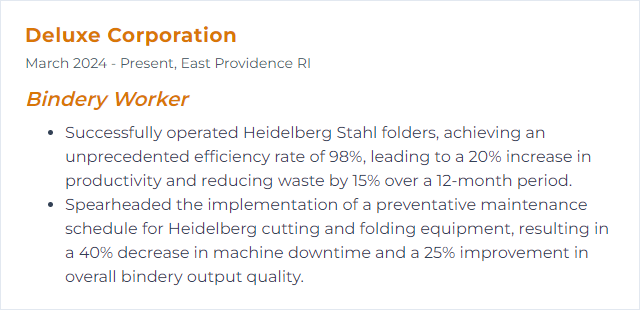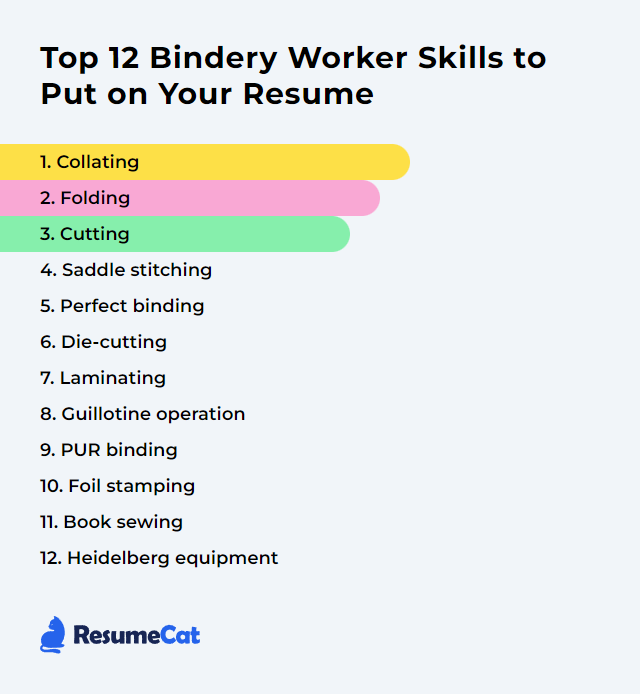Top 12 Bindery Worker Skills to Put on Your Resume
In the competitive field of bindery work, showcasing a robust set of skills on your resume can significantly elevate your chances of securing your desired position. This article outlines the top 12 skills that bindery workers should highlight to demonstrate their expertise and adaptability in the ever-evolving print finishing industry.
Bindery Worker Skills
- Collating
- Folding
- Cutting
- Saddle stitching
- Perfect binding
- Die-cutting
- Laminating
- Guillotine operation
- PUR binding
- Foil stamping
- Book sewing
- Heidelberg equipment
1. Collating
Collating in a bindery context refers to the process of gathering and arranging individual sheets or sections of a publication in their correct sequence before binding.
Why It's Important
Collating is important for a Bindery Worker because it ensures that pages or sheets are arranged in the correct order before binding, guaranteeing the final product is organized and functional for the end-user.
How to Improve Collating Skills
Improving collating in a bindery setting focuses on optimizing efficiency, accuracy, and productivity. Here are concise strategies:
Upgrade Equipment: Invest in automated collating machines that offer higher speeds and precision.
Regular Maintenance: Service machines on a schedule to prevent malfunctions and downtime.
Employee Training: Provide thorough training on setup, operation, and basic troubleshooting.
Quality Control Processes: Add checkpoints and sampling at multiple stages to catch sequence or orientation errors fast.
Workflow Optimization: Streamline job flow to reduce bottlenecks; stage materials and standardize job tickets.
Use of Software: Leverage imposition and pre-collation tools to minimize errors before production begins.
By focusing on these areas, bindery workers can improve the collating process, boosting throughput and final quality.
How to Display Collating Skills on Your Resume
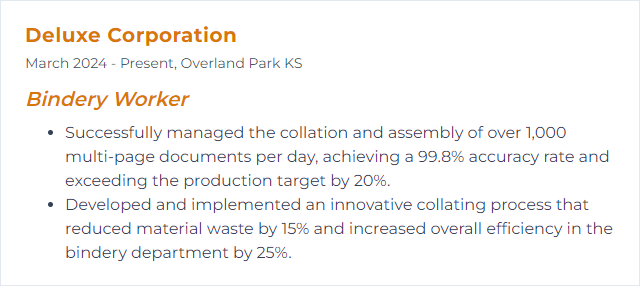
2. Folding
Folding, in the context of a bindery worker, refers to the process of bending and creasing paper or other materials into specific shapes or sizes, often as part of the bookbinding or packaging process.
Why It's Important
Folding is crucial for a Bindery Worker as it ensures precision in aligning pages, contributes to the professional appearance and durability of the final product, and facilitates the efficient assembly of books, brochures, and other printed materials.
How to Improve Folding Skills
Improving folding as a Bindery Worker involves honing skills, understanding machinery, and implementing best practices. Here’s how:
Understand Your Machinery: Learn the nuances of each folder you run—settings, limitations, setup quirks.
Regular Maintenance: Clean sensors and rollers, inspect belts, and keep plates and guides true.
Material Knowledge: Factor in paper weight, grain direction, coating, and humidity when choosing fold types and settings.
Precision in Setup: Square stock, dial in stops and plates carefully, and verify fold accuracy with short test runs.
Continuous Learning: Study trade publications, vendor manuals, and peer tips to refine technique.
Practice: Try varied stocks and complex folds to expand your range and confidence.
Quality Control: Check samples throughout the run for creep, cracking, skew, and split fibers; adjust promptly.
Professional forums, shop standards, and vendor guidance can sharpen folding consistency and speed without guesswork.
How to Display Folding Skills on Your Resume
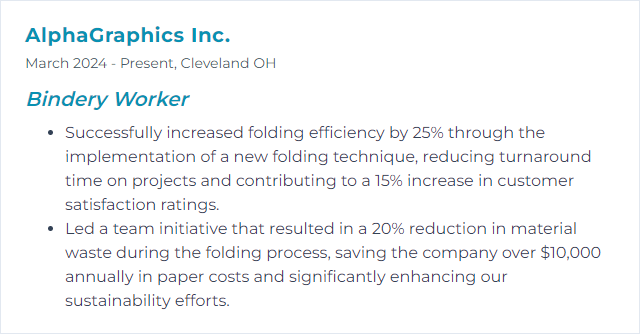
3. Cutting
Cutting, in the context of a Bindery Worker, refers to the process of using machines or hand tools to trim pages and materials to specific dimensions as part of the bookbinding or finishing process.
Why It's Important
Cutting is crucial for a Bindery Worker because it ensures precision in trimming materials to exact specifications, essential for high-quality and uniform finished products.
How to Improve Cutting Skills
To enhance cutting accuracy and efficiency as a Bindery Worker, follow these concise steps:
Sharpen Blades Regularly: Dull blades tear and crush. Keep a sharpening schedule and track blade life.
Maintain Equipment: Calibrate back-gauges, check clamps, and verify squareness to maintain consistency.
Use the Right Tools: Match knives, cutting sticks, and pads to stock type and thickness. Vendors like C&T Matrix specialize in solutions.
Follow Safety Procedures: Adhere to lockout/tagout, guards, and safe hand positions—safety first, always.
Measure Twice, Cut Once: Confirm trim sizes, grain, and lift height before committing to full runs.
Practice Good Housekeeping: Keep the bed clean, clear scrap often, stage lifts and jogs to stay orderly.
Invest in Training: Seek training from industry associations and equipment vendors for advanced techniques and troubleshooting.
These habits drive cleaner edges, tighter tolerances, and fewer remakes.
How to Display Cutting Skills on Your Resume
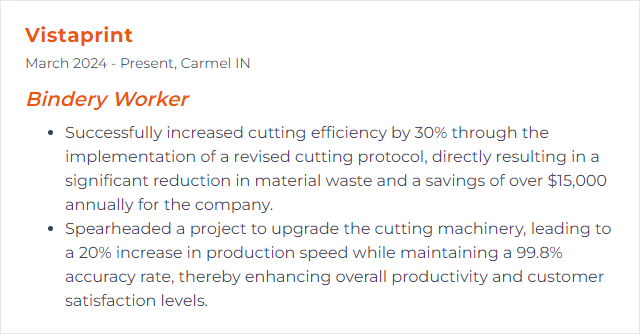
4. Saddle stitching
Saddle stitching is a binding process where folded sheets are gathered together one inside the other and then stapled through the fold line with wire staples.
Why It's Important
Saddle stitching is important for a Bindery Worker because it provides a quick, cost-effective method for assembling smaller booklets, magazines, and catalogs, ensuring a neat, professional finish.
How to Improve Saddle stitching Skills
To improve saddle stitching, follow these concise steps:
Machine Calibration: Keep head timing, wire length, and clincher settings in spec for consistent stitch placement.
Material Preparation: Jog signatures square, control creep, and ensure covers are scored correctly to prevent cracking.
Stitch Quality: Use high-quality wire, monitor leg length, and adjust clinchers for tight, flat stitches. Vendors like Deluxe Stitcher share useful practices.
Regular Maintenance: Clean, lubricate, and replace wear parts before they cause jams or misfires.
Operator Training: Train operators on changeovers, jam clearing, and quality checks to keep uptime high.
Dialed-in setup and attentive upkeep are the difference between smooth runs and stop-start chaos.
How to Display Saddle stitching Skills on Your Resume
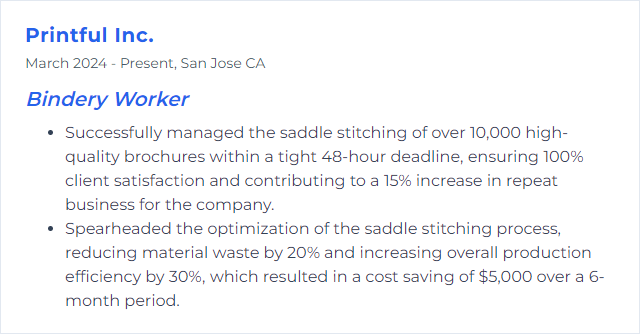
5. Perfect binding
Perfect binding is a method where pages and cover are glued together at the spine with a strong yet flexible thermal adhesive for a smooth and sleek finish.
Why It's Important
Perfect binding is important because it provides a clean, professional finish to books and documents, offering durability and allowing for printing on the spine, enhancing aesthetic appeal and marketability.
How to Improve Perfect binding Skills
To enhance perfect binding, focus on these concise steps:
- Preparation: Mill and notch the spine properly to promote adhesive penetration and fiber exposure.
- Adhesive Application: Select the right adhesive (EVA or PUR) for the job and apply evenly at proper temperature and film weight.
- Nipping and Pressing: Set nipper pressure and dwell to square the book block and ensure strong cover adhesion.
- Curing Time: Allow adequate curing—PUR requires longer cure but delivers superior strength and lay-flat performance.
- Quality Control: Test page-pull and flex, check for glue squeeze-out, and monitor spine grind depth throughout the run.
Meticulous prep, adhesive choice, and patient curing pay off with fewer returns and tougher books.
How to Display Perfect binding Skills on Your Resume
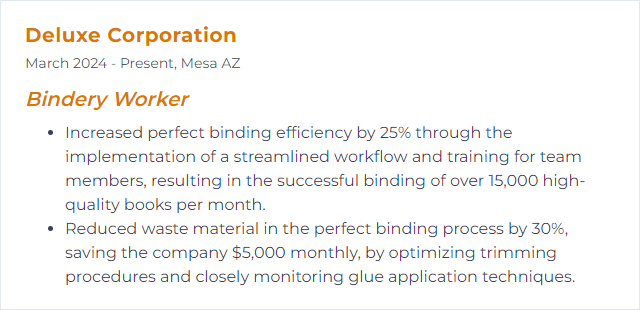
6. Die-cutting
Die-cutting is a precision cutting process used in bindery and printing work to shape and cut materials into specific, intricate designs with a custom-shaped blade, known as a die, often used for creating unique packaging, labels, and business cards.
Why It's Important
Die-cutting is essential for a Bindery Worker as it allows for precise cutting of materials into specific shapes or designs, enabling the creation of custom packaging, unique business cards, decorative elements, and more, thus enhancing the quality and variety of finished products offered to clients.
How to Improve Die-cutting Skills
To improve die-cutting as a Bindery Worker, focus on the following concise steps:
Maintenance: Follow manufacturer cleaning and lubrication schedules to keep tolerances tight.
Material Preparation: Condition stock, control humidity, and confirm grain direction to avoid cracking and incomplete cuts.
Die Quality: Use high-quality dies, check rule height and nicks, and replace worn make-ready quickly.
Machine Calibration: Set pressure, speed, and packing precisely for each material and thickness to minimize waste.
Training: Build skills through vendor sessions and hands-on practice with varied substrates and complex shapes.
Attention to setup and maintenance turns tricky outlines into crisp, repeatable results.
How to Display Die-cutting Skills on Your Resume
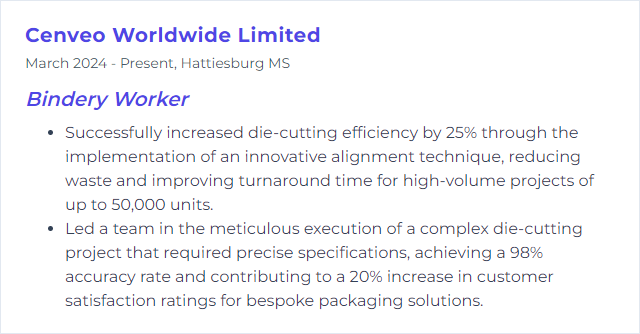
7. Laminating
Laminating, in the context of bindery work, refers to the process of applying a thin plastic film over paper or card products to protect and enhance their durability, appearance, and longevity.
Why It's Important
Laminating is important for a Bindery Worker because it provides a protective layer that enhances durability, preserves the quality, and improves the appearance of printed materials, ensuring they withstand handling and last longer.
How to Improve Laminating Skills
To improve laminating as a Bindery Worker, focus on the following concise steps:
- Material Preparation: Ensure materials are clean, dry, and dust-free for a flawless finish.
- Machine Calibration: Match temperature, speed, and pressure to film type and stock; record winning settings.
- Test Runs: Run short tests, check for silvering and tunneling, then adjust before full production.
- Proper Feeding: Feed straight and centered, maintain even tension, and avoid overlaps at the nip.
- Regular Maintenance: Clean rollers, inspect heaters and sensors, and replace worn parts promptly.
Well-kept machines and disciplined setup habits drive clear, bubble-free laminates that hold up under use.
How to Display Laminating Skills on Your Resume
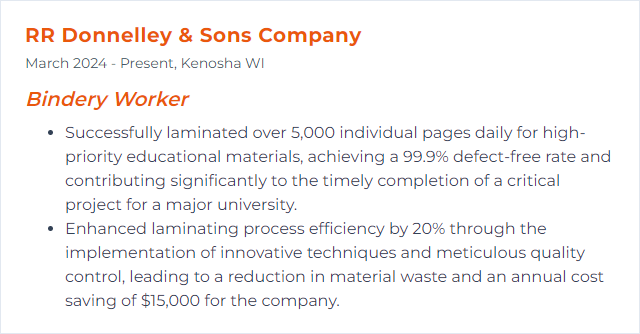
8. Guillotine operation
In bindery, a Guillotine operation refers to the cutting or trimming of paper or book materials using a Guillotine cutter, a machine equipped with a large blade that makes straight cuts through stacks of paper with precision and efficiency.
Why It's Important
The guillotine operation is important for a Bindery Worker because it ensures precise and efficient cutting of paper or other materials to exact specifications, essential for high-quality bookbinding and finishing processes.
How to Improve Guillotine operation Skills
Improving guillotine operation in a bindery involves ensuring safety, maintaining the equipment, and optimizing workflows. Here are concise steps:
- Safety Training: Provide job-specific training on guards, two-hand controls, and emergency stops.
- Regular Maintenance: Sharpen and change knives on schedule, check clamp pressure, and lubricate mechanisms.
- Quality Blades: Use high-grade knives and compatible cutting sticks for clean edges.
- Material Handling: Jog lifts square, control lift height, and stage work to reduce idle time.
- Workflow Optimization: Plan cutting sequences, save programs, and use barcodes or presets to speed changeovers.
- Ergonomics: Set bench heights and lift aids to reduce strain and keep throughput steady.
Small, steady improvements compound into faster cuts and safer shifts.
How to Display Guillotine operation Skills on Your Resume
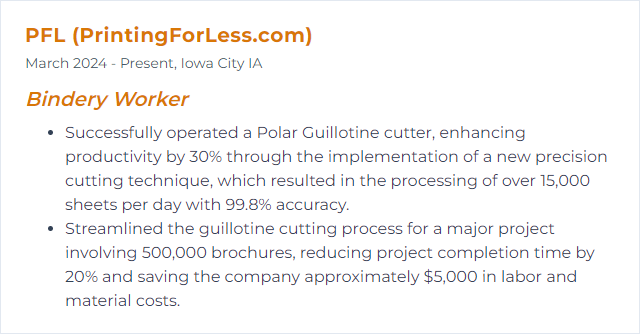
9. PUR binding
PUR binding, short for Polyurethane Reactive binding, is a method of bookbinding that uses a durable, flexible adhesive to securely bind pages together, creating a strong, long-lasting bond suitable for a wide range of print materials.
Why It's Important
PUR binding, using polyurethane reactive adhesive, offers superior durability, flexibility, and lay-flat properties for books. It's crucial for bindery workers as it ensures high-quality, long-lasting products, suitable for a wide range of materials and applications.
How to Improve PUR binding Skills
Improving PUR (Polyurethane Reactive) binding involves focusing on preparation, application, and curing processes. Ensure the spine is milled to the correct depth and notches are clean for optimal adhesive penetration. Use a quality PUR adhesive and apply it at the recommended temperature and thickness. Make sure the book block is properly jogged and aligned before entering the binder. After binding, allow about 24 hours of cure at room temperature with controlled humidity to achieve full strength. Keep equipment clean, purge adhesive properly, and follow the adhesive supplier’s instructions for consistent results.
How to Display PUR binding Skills on Your Resume
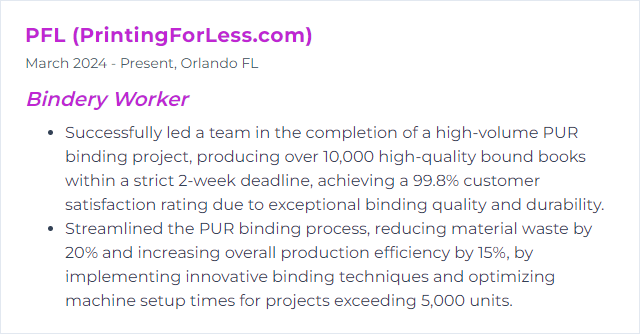
10. Foil stamping
Foil stamping is a printing process where metallic or pigmented foil is applied to a surface using heat and pressure, creating decorative finishes or lettering on books, invitations, or business cards.
Why It's Important
Foil stamping is important for a Bindery Worker as it adds value and appeal to printed materials by applying metallic or pigmented foil onto the surface, enhancing the product's aesthetic, attracting attention, and differentiating it in the market.
How to Improve Foil stamping Skills
To improve foil stamping, a bindery worker should:
Ensure proper machine setup: Match temperature, pressure, and dwell time to the foil and substrate; record your winning recipes.
Use high-quality materials: Select foils and stocks that are compatible and consistent across lots.
Regular maintenance: Keep dies clean, check makeready, and replace worn packing before defects appear.
Test runs: Proof on the actual stock to fine-tune coverage, registration, and release before full runs.
Continuous learning: Follow guidance from foil and equipment suppliers and stay current with trade association tips and trends.
Good foil work pops off the page—clean edges, even coverage, confident impressions.
How to Display Foil stamping Skills on Your Resume
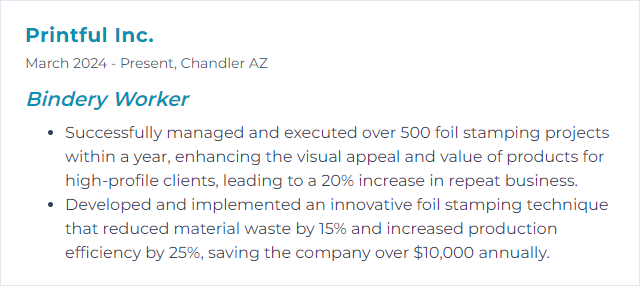
11. Book sewing
Book sewing is a binding technique where folded sheets are stitched together along the spine before being attached to the book cover, ensuring durability and a professional finish.
Why It's Important
Book sewing is crucial for a Bindery Worker as it enhances the durability and longevity of books, ensuring they can withstand frequent handling and usage. This traditional binding method also allows books to lay flat when open, improving readability and user experience.
How to Improve Book sewing Skills
Improving book sewing involves enhancing both the quality and efficiency of the binding process. As a bindery worker, focus on these concise steps:
Material Preparation: Use appropriate thread, confirm signature fold accuracy, and pre-punch where needed.
Machine Setup: Set stitch length and tension correctly; keep needles, hooks, and guides aligned and well-maintained.
Sewing Technique: Master true sewing methods such as Smyth sewing, kettle stitch, and Coptic stitching, choosing the approach that fits the format and use case.
Quality Control: Inspect for skipped stitches, loose threads, and misaligned signatures before casing-in or further finishing.
Continuous Learning: Practice on varied stocks and book sizes; document settings that yield reliable, flat-laying results.
Solid sewing turns frequent-use books into long-haul companions.
How to Display Book sewing Skills on Your Resume
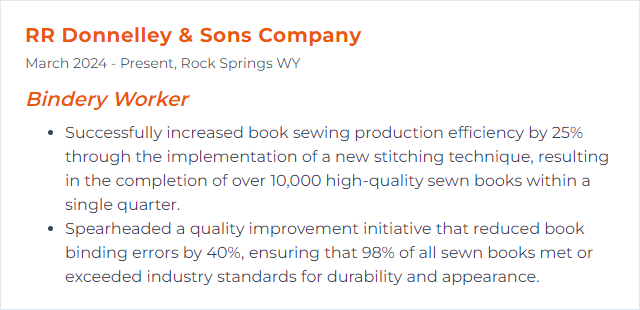
12. Heidelberg equipment
Heidelberg equipment refers to high-quality printing and finishing machinery produced by Heidelberg, a leading manufacturer in the printing industry. For a Bindery Worker, this would involve machines for cutting, folding, gluing, and binding printed materials to create finished products like books, brochures, and magazines.
Why It's Important
Heidelberg equipment is crucial for a Bindery Worker because it represents high-quality, efficient, and versatile printing and finishing solutions, enabling precise cutting, folding, and binding tasks essential for producing professional-grade printed materials.
How to Improve Heidelberg equipment Skills
Improving Heidelberg equipment performance in a bindery environment involves maintenance, training, and process optimization. Tips:
Regular Maintenance: Follow scheduled inspections, replace wear parts, and keep firmware and software current.
Operator Training: Provide formal training and cross-training so operators understand setup, diagnostics, and recovery.
Optimize Workflow: Minimize idle time with standardized job tickets, preset libraries, and staged materials.
Use Genuine Parts and Supplies: Stick with compatible parts and approved consumables to protect reliability and accuracy.
Implement Preventive Measures: Clean sensors, check alignment, and log issues early to prevent escalations.
Stay Up-to-Date: Apply updates and consider retrofit kits that enhance safety, automation, or makeready speed.
Well-trained operators on well-cared-for equipment make deadlines feel less like cliff edges and more like targets.
How to Display Heidelberg equipment Skills on Your Resume
